Isle of Man ships in WWI
The Isle of Man, naturally, is dominated by its position in the Irish Sea. Although specialist equipment had to be imported, with 75% of the land used for agriculture, it has always had a thriving farming community. However, by the outbreak of the Great War, seasonal holiday trade from the mainland boosted the population during the summer. Thousands of working class people would visit the island each year and boarding house owners. A camp site would accommodate thousands of visitors during the season. The only way they could access the island was by sea and the Isle of Man Steam Packet company had a fleet of ships for this purpose.
When war was declared in 1914, the IOM Steam Packet Company had a fleet of fifteen steamers. Eleven of these were either chartered or purchased by the Government for war purposes and fitted out and armed as quickly as possible in order to adapt them for their special work.
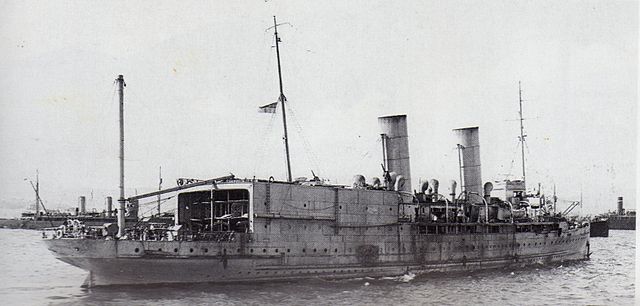 HMS Ben my Chree
HMS Ben my Chree
Being a fleet of vessels especially suited for passenger carrying, and unsurpassed by any other coasting steamers in the world, as far as speed and accommodation were concerned, it seemed, to the uninitiated, natural to expect that their services would be required for the conveyance of troops across the Channel, a work for which they were so particularly well adapted. However, this was not the work most were called upon to perform, except for of two of them, the Empress Queen and Mona’s Queen. The others were destined to be seaplane-carriers, net-laying ships, armed boarding-vessels, and one, the King Orry, became attached to the Grand Fleet.
It was ironic that these vessels, usually employed in carrying thousands of light-hearted holiday-makers, should suddenly be transformed for the grim purposes of war. Each one of them rendered valuable service, but only four returned at the end the War to resume their peaceful trade. These four were the Peel Castle, Viking, King Orry, and Mona’s Queen. Of the remainder, four were lost, and three were retained by the Government.
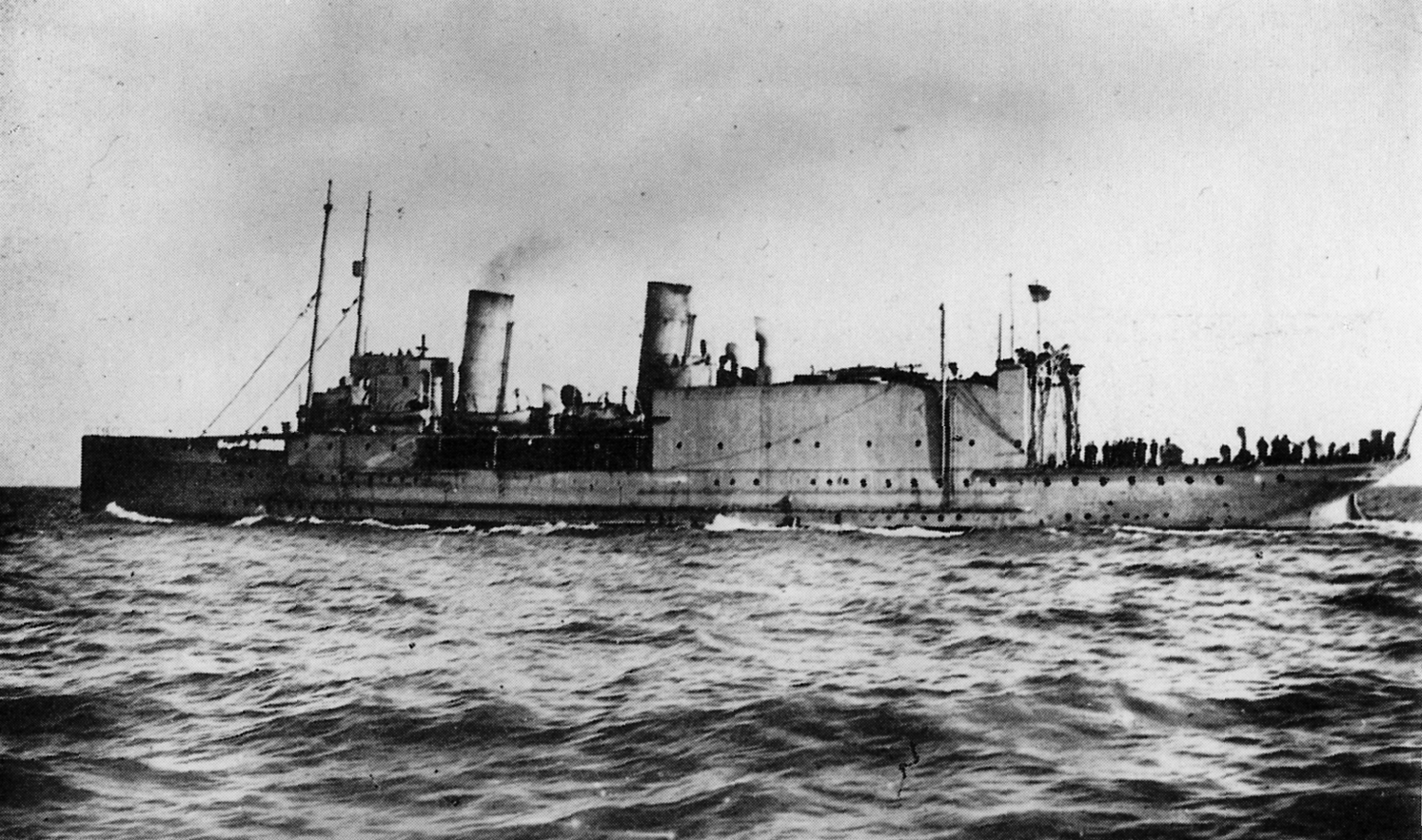 HMS Vindex
HMS Vindex
The flag ship of the Company was the Ben-my-Chree (Woman of my Heart). The third ship so named, she was built by Vickers at Barrow-in-Furness in 1907 for the IOM Steam Packet Company Liverpool–Douglas service. Due the cost of construction she was only used in the peak summer months. She was chartered by the Royal Navy on 1 January 1915 and converted to a sea-plane launcher. Behind her rear funnel the deck was converted to a hangar to hold 6-8 aircraft. To the bow a take off ramp was laid with derricks to lift the aircraft onto the launching rails. She was armed with 4 quick firing 12lb guns and was subsequently given further armament.
She was initially assigned to the Harwich Force, under the command of Commander Cecil L'Estrange Malone, where on 3 May 1915 she took part in an abortive air raid on Norddeich (a German port north of Holland). It had to be abandoned because of thick fog. On 6 May, while on another unsuccessful mission to attack Norddeich, she was accidentally rammed by the destroyer Lennox in thick fog, although damage was slight. Another attempt was made on 11 May, but was again abandoned because of heavy fog. During this raid, Ben-my-Chree attempted to launch her Sopwith Schneider from a trolley off the fore deck, but the engine backfired, wrecking its starter, and breaking the pilot's wrist as the starter handle was in the cockpit.
In May 1915, she sailed for the Dardanelles, carrying two Short Type 184 torpedo bombers, and arrived at Lesbos on 10 June. Her aircraft were mainly involved in spotting for ships providing naval gunfire support for troops ashore, although they also conducted reconnaissance missions of the area. On 11 August, one of these missions had spotted a Turkish ship off the north coast of the Sea of Marmora and, on the following day, Flight Commander Charles Edmonds attacked it, flying a Short 184 seaplane. He left his observer behind and flew with a reduced fuel load to lighten his aircraft enough to carry a 14-inch, 810 pound torpedo. He successfully dropped his aerial torpedo at a distance of about 800 yards (730 m) and an altitude of 15 feet. In fact his target had been beached after having been torpedoed by the British submarine E14. This was followed by a successful attack by Edmonds on 17 August against a 5,000 ton ship. Flight Lieutenant George Dacre accompanied Edmonds on his flight in his own aircraft, but suffered engine troubles and had to land in the Dardanelles. He was taxiing on the water when he encountered a large steam tugboat, which he promptly torpedoed. After taxiing for several miles he was able to get airborne again and was within gliding distance of Ben-my-Chree when his engine failed permanently.
On 2 September, she helped to rescue Australian troops from the torpedoed troopship HMT Southland off Lemnos. The ship was transferred to Port Said, Egypt after the end of the Gallipoli Campaign. Ben-my-Chree became the flagship of the East Indies and Egypt Seaplane Squadron when it was formed in January 1916. The squadron was under the command of the General Officer Commanding, Egypt and its primary duty was to watch Turkish positions and movements in southern Palestine and the Sinai. SS Uganda collided with her on 11 February and badly damaged the ship's bow. Permanent repairs were made at Suez from 13 March to 25 April. Commander Charles Samson replaced L'Estrange Malone as captain on 14 May. A few days later, Lieutenant William Benn joined the ship as an observer. Ben-my-Chree was based at Aden later in 1916.
The ship first came under fire when French troops occupied the Greek island of Kastellorizo, off the southwest coast of Turkey, on 20 December 1916 to use it as an advance base against the Turks. Not pleased at the presence of the French, the Turks secretly deployed an artillery battery of four 6.1 in and twelve 3.0 in guns within range of the island. The French commander requested a seaplane carrier to conduct reconnaissance in the area and Ben-my-Chree was sent in response. She arrived on 11 January 1917 and anchored in the harbour which faced the mainland. The Turkish guns opened fire about two hours later, hitting the carrier with their third shot. Subsequent shells disabled her steering and started a fire in her hangar that spread across her upper deck.
The crew was ordered to abandon ship after about forty minutes of the bombardment using the only remaining operable motor lifeboat of the three stowed on board. One officer and four enlisted men were injured, but no one was killed. The Turks continued their bombardment for five hours until Ben-my-Chree listed to starboard and sank in shallow water. Later in the day, the captain and the chief engineer returned to the wreck to rescue the ship's mascots, a cat and dog which had both survived the attack.
During her short career she operated Sopwith Type 860, Schneider, and Baby, as well as Short Type 830 and Type 184 floatplanes.
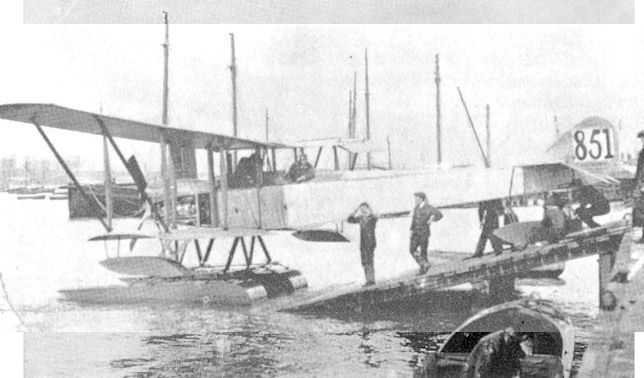 Sopwith Type 860
Sopwith Type 860
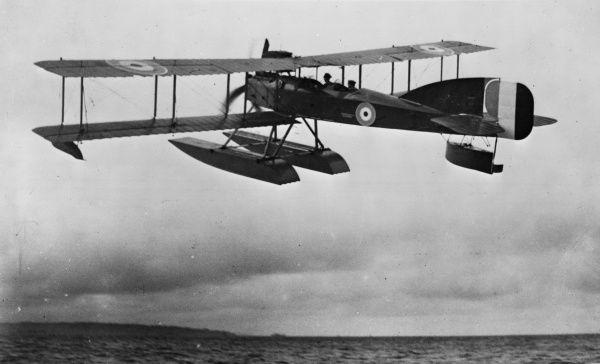 Short Type 184
Short Type 184
Ben-my-Chree's wreck remained in place until 1920 when it was re-floated by the salvage ship Vallette and towed to the port of Piraeus. The ship proved to be a constructive total loss and was broken up in Venice, Italy in 1923.
King Orry was the Island’s last ship built before the war and the Company’s first one to have geared turbines. She was used as an armed boarding vessel. In November 1914, armed with 2 four inch guns she patrolled Scapa Flow. She assisted stricken ships and provided prize crews on appropriate ships. This included a merchantman laden with 10k tons of wheat bound for Germany. A prize crew took the seized vessel into Kirkwell, despite colliding with the destroyer Christopher. In 1940, she was sunk at Dunkirk.
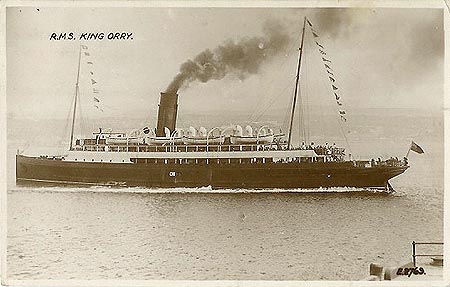 RMS King Orry
RMS King Orry
The seamen of the island were also involved with rescue of stricken vessels. Thomas Woods was in his vessel The Wanderer was off the south coast of Ireland when the Lusitania was torpedoed on 7 May 1915. With his crew he was able to save 120 people.
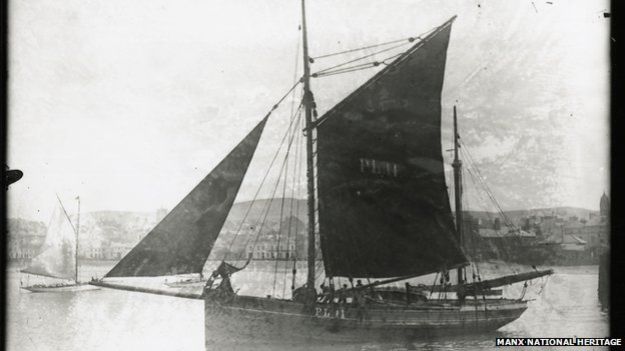
The Wanderer
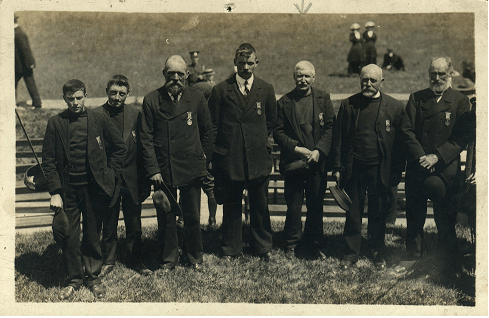 Wanderer Crew, Captain is 3rd from left
Wanderer Crew, Captain is 3rd from left
The Viking was built in 1905 by Armstrong Whitworth, Newcastle upon Tyne as, a fast passenger ferry for the Isle of Man Steam Packet. Viking was requisitioned by the Royal Navy on 26 March 1915 for conversion to a seaplane carrier, and was purchased outright on 11 November 1915. She was renamed HMS Vindex to avoid confusion with the destroyer HMS Viking.
Vindex was assigned to the Harwich Force in November 1915 and operated in the North Sea throughout 1917. A Bristol Scout C flown by Flight Lieutenant Harold Towler made the first take-off from the ship on 3 November 1915 with the ship steaming at 12 knots; the aircraft only used 46 feet of the flight deck and it was the first take-off by a landplane from a Royal Navy ship.
On 25 March 1916, Vindex attempted to attack the Zeppelin base at Tondern with three Short Type 184s and two Sopwith Baby floatplanes, but the attack was ineffective. It did, however, draw out elements of the German Navy so it was repeated on 4 May with the addition of HMS Engadine. The two ships carried eleven Babies between them, each armed with 65-pound bombs, but eight failed to take-off; one hit the mast of an escorting destroyer and one had to return due to engine trouble. No damage was inflicted, but one Zeppelin was shot down by a cruiser when it sortied to find the British ships. On 2 August one of her Bristol Scouts unsuccessfully attacked the Zeppelin LZ 53 (L17) with explosive Ranken darts, the first interception of an airship by a carrier-based aircraft in history. Vindex was to provide aerial reconnaissance with two of her seaplanes for a Coastal Motor Boat raid on 22 October 1916, but the operation was aborted because of fog.
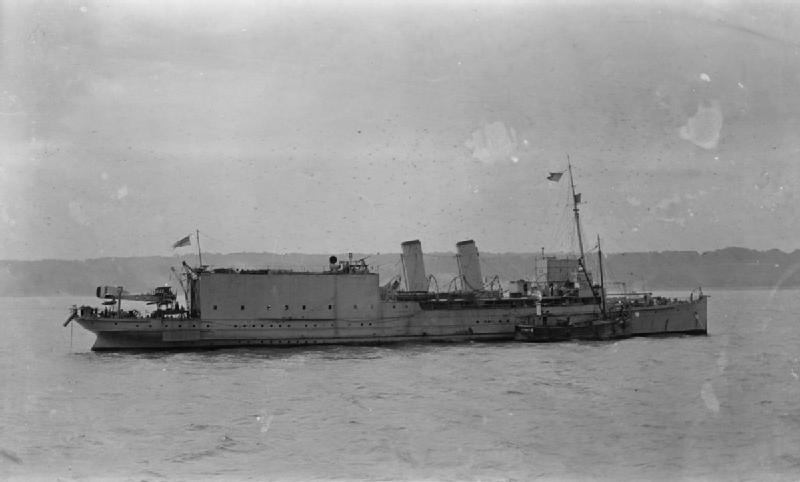 HMS Engadine
HMS Engadine
The ship was transferred to the Mediterranean Fleet at Malta in 1918, where she served until she was paid off in late 1919. Vindex was originally intended to be retained for service with the fleet after the end of the war, but this proved to be too expensive and she was sold back to her original owners on 12 February 1920 and reverted to her original name. She was requisitioned again in 1939 and served through the Second World War as a troopship, but not under her earlier name. She was returned to her owners in 1945 and was finally sold for scrap in 1954.
Empress Queen was built by the Fairfield Shipbuilding and Engineering Company, Govan in 1897 at a cost of £130,000. Prior to her launch the directors of the Isle of Man Steam Packet Company issued a circular in which they invited the shareholders of the Company to decide on the name of the vessel - the choices offered being Empress Queen or Douglas. The name chosen was Empress Queen, adopted in honour of Queen Victoria's Diamond Jubilee.
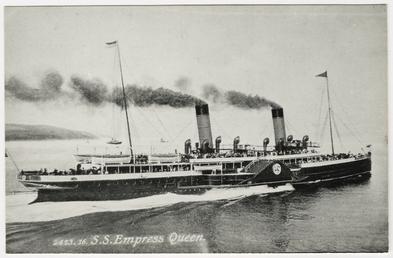 Empress Queen
Empress Queen
The decision did not meet with universal approval; the Isle of Man Times of Tuesday January 19, 1897, disregarding sentiment and citing practicality, stated in an editorial that it thought it better to use the name Douglas, as it would be more easily recognised by passengers. In addition it was revealed that the decision had been taken by English shareholders, who formed the majority of the Company's shareholding. With the decision on the vessel's name decided the launch date was initially fixed for February 18, 1897 - the christening ceremony to be performed by Mrs Margaret Mylrea, wife of Chairman of the Isle of Man Steam Packet Company, John Allen Mylrea.
The launch had to be delayed when a fire broke out in Fairfield's yards in February 1897. The fire caused major damage to the yard and threatened the cruiser HMS Argonaught at that time on the stocks under construction, as well as various other vessels including the Empress Queen. However, due to the vessels being separated from the buildings no damage was sustained. Consequently, the launch was rescheduled.
Empress Queen was successfully launched at 13:00hrs on Thursday March 4, 1897. A large delegation of directors and officials from the Isle of Man Steam Packet Company were present, along with Sir William Pearce, Chairman of Fairfield Shipbuilding and Engineering Company, Admiralty representatives and visitors from Liverpool, Edinburgh and Glasgow.
Empress Queen was the largest and fastest paddle-driven cross-channel steamer ever to be built. Her tonnage was 2,140 GRT; length 360 ft 1 in; beam 42 ft 3 in, depth 17 ft. The paddle wheels were constructed of steel on the feathering principle with curved floats.
The engines were able to give the ship a service speed of 21.5 knots At the time, her engines and paddle wheels were claimed to be the heaviest ever placed in a paddle steamer, with one paddle shaft wheel alone weighing 70 tons.
In order to facilitate better handling in port, Empress Queen was fitted with a bow rudder in addition to the stern rudder The hull was divided into several watertight compartments by means of steel transverse bulkheads which additionally augmented the strength of the hull forming supports and ties between the decks and framing. Two steam capstans windlasses were fitted forward for working the ship's cables and forward was a double acting steam winch which was used for the loading and unloading of luggage.
Empress Queen's design and layout was very much suited to the late Victorian era. She was a full poop vessel, consisting of four decks: Lower, Main, Bridge and Promenade. She was designed primarily for the carriage of passengers, but she could also accommodate a quantity of cargo. Her designation as a Royal Mail Ship (RMS) indicated that she carried mail under contract with the Royal Mail. Situated on the main deck was a specified area, allocated for the storage of letters, parcels and specie (bullion, coins and other valuables). Empress Queen was ideally suited as a troop carrier. On leaving Douglas she steamed to Barrow and was fitted out for her wartime role in less than two weeks. Following her fitting out, she then made passage to Southampton and two days later was on the first of her duties, taking 1,900 men of a Scottish regiment to Le Havre.
Her end was unexpected. Empress Queen had been regarded by the authorities as an exceptionally reliable paddle steamer; she had never stopped for weather or engine trouble. Then, on 1 February 1916, she was returning to Southampton from Le Havre with 1,300 men on board. The weather was foul, the visibility was but a few yards, when she ran ashore at 05:00hrs on the Ring Rocks off Bembridge, Isle of Wight. She ran well up on to them on a rising tide, the wind was light, and the sea was calm.
Destroyers took off the troops, the crew remained on board as efforts were made to pull the vessel off. It was not expected to be a difficult task, but it proved impossible. The weather changed in a matter of hours and a gale blew up. The Queen Victoria was launched from the Bembridge Lifeboat Station to undertake rescue operations. Bembridge coxswain John Holbrook injured his hand while fastening a line to the stricken vessel, but nevertheless made four trips between the ship and the shore, rescuing 110 people. And additional nine people were rescued by another vessel. Holbrook was awarded an RNLI silver medal for his actions.
The Empress Queen, regarded as the fastest paddle steamer of her day when Fairfield's built her in 1897, and certainly the finest of her type to see service with the Steam Packet Company, was broken up by the wind and tide as the seasons passed. She became a familiar landmark to Southampton and Portsmouth shipping. Her two funnels were still to be seen above the water on Armistice Day. During the following summer, after a long and heavy gale, they finally disappeared.
To be continued.
Terry Jackson
